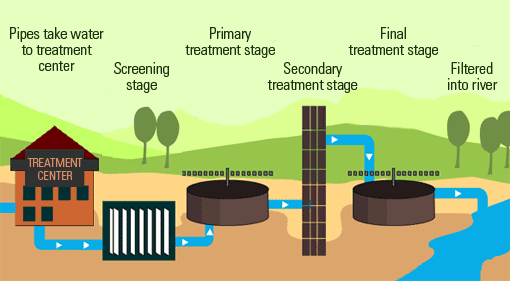Strategic Approaches to Improve Drainage Therapy Performance and Decrease Environmental Impact
In the world of waste water treatment, the mission for improved efficiency and minimized ecological effect is a perpetual difficulty that requires calculated remedies. As society comes to grips with the critical to take care of water resources sustainably, a nuanced technique ends up being important. The combination of sophisticated treatment technologies, energy-efficient procedures, source healing approaches, boosted nutrient removal methods, and clever monitoring and control systems represents a diverse structure for dealing with these pressing concerns. What exists at the core of this facility web of techniques is the possible to change the means we approach waste water therapy, not simply as a procedure of disposal, but as a useful opportunity for advancement and ecological stewardship.
Advanced Treatment Technologies
Cutting-edge membrane layer filtering systems have actually changed advanced wastewater treatment procedures, substantially enhancing the removal of impurities. This innovation has shown to be highly efficient in getting rid of a wide array of impurities, consisting of pharmaceuticals, heavy metals, and natural substances, which are usually challenging to get rid of through typical treatment techniques.
Furthermore, membrane layer filtration systems offer numerous advantages over traditional therapy approaches. In addition, these systems are very functional and can be quickly incorporated into existing therapy plants or used as standalone systems for decentralized applications.
Energy-Efficient Processes
The combination of energy-efficient processes in wastewater treatment systems is critical for enhancing resource utilization and minimizing functional prices. By implementing energy-efficient modern technologies, therapy plants can significantly decrease their carbon footprint and general ecological impact. One essential approach to enhancing power performance in wastewater therapy is the use of sophisticated oygenation systems, such as fine bubble diffusers or surface aerators, which can improve oxygen transfer effectiveness and minimize power consumption. Additionally, including energy recovery systems, like anaerobic digestion for biogas manufacturing or making use of excess heat for thermal processes, can help counter power needs and advertise sustainability.
Furthermore, enhancing process control and automation with using sophisticated sensors and checking systems can enhance total power efficiency by readjusting operations in real-time based on actual need and conditions. Executing power audits and regularly monitoring power performance indicators are essential methods to determine locations for improvement and track energy-saving efforts effectively. On the whole, the adoption of energy-efficient processes in wastewater therapy not just profits the atmosphere however likewise adds to long-term expense financial savings and functional sustainability.
Source Healing Techniques
With a concentrate on optimizing source utilization and sustainability in wastewater treatment systems, the execution of source recovery methods becomes a critical aspect in improving functional effectiveness. Source healing strategies in wastewater therapy include the recognition and removal of beneficial sources from the waste stream, thus turning what was once taken into consideration waste into a valuable possession. By executing resource healing strategies such as nutrient removal and recuperation, energy generation from natural matter, and the manufacturing of multiple-use water, wastewater therapy plants can lessen ecological impact while optimizing performance.

Boosted Nutrient Removal Strategies
Executing sophisticated nutrient removal techniques is essential for maximizing the visit here performance of wastewater treatment systems. One of the crucial strategies used for enhanced nutrient elimination is the process of organic nutrient elimination (BNR), which entails the removal of nitrogen and phosphorus via organic procedures.

Along with BNR, advanced treatment methods such as membrane layer bioreactors (MBRs) and constructed marshes can additionally be employed to improve nutrient removal effectiveness. MBRs utilize membranes to achieve top quality effluent standards by efficiently removing nutrients and put on hold solids. Built wetlands mimic all-natural marsh processes to eliminate nutrients with plant uptake, microbial task, and sedimentation. By integrating these sophisticated nutrient elimination methods right into wastewater therapy systems, towns and markets can properly lower nutrient pollution and shield the atmosphere.
Smart Monitoring and Control Systems
Making use of innovative technology, the integration of clever monitoring and control systems reinvents the operational performance of wastewater treatment centers. These systems integrate advanced sensors and data analytics to constantly monitor vital criteria such as pH levels, turbidity, liquified oxygen, and circulation rates in real-time. By gathering and analyzing this data, drivers can obtain valuable understandings right into the efficiency of the therapy processes, enabling proactive changes reference to enhance treatment performance.
Smart surveillance and control systems likewise support remote monitoring capabilities, permitting drivers to gain access to real-time information and control features from off-site locations. This remote availability enhances functional versatility and responsiveness, making it possible for quick interventions in case of system breakdowns or variations in influent high quality. The predictive upkeep abilities of these systems help prevent tools failings and lessen downtime, eventually improving the general integrity of wastewater treatment procedures.
Verdict
To conclude, calculated techniques such as sophisticated treatment modern technologies, energy-efficient processes, source recovery strategies, enhanced nutrient elimination techniques, and wise monitoring and control systems play a critical role in improving wastewater treatment efficiency and decreasing environmental influence. By executing these strategies, wastewater therapy plants can enhance their overall performance, decrease power usage, recuperate important resources, and guarantee conformity with ecological laws. These methods are important for sustainable and efficient wastewater monitoring practices.

In final thought, strategic approaches such as innovative treatment innovations, energy-efficient processes, source healing methods, enhanced nutrient elimination methods, and smart tracking and control systems play an essential role in enhancing wastewater treatment performance and minimizing environmental effect.
Comments on “Enhanced Waste Water Treatment Solutions for Lasting Water Administration”